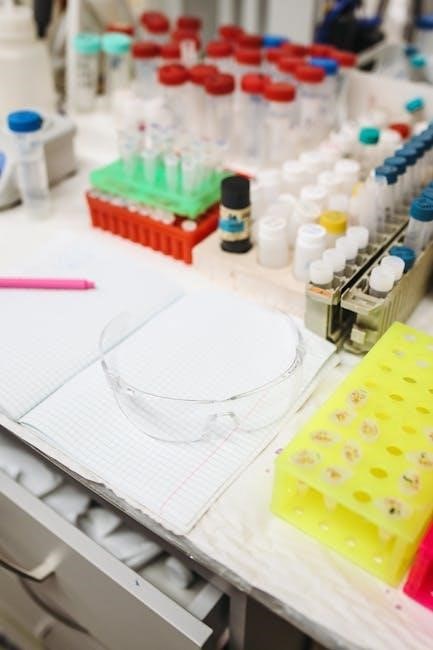Chemistry is the scientific study of matter and its transformations. It explores the composition‚ properties‚ and reactions of substances. Unit 1 introduces foundational concepts‚ including the metric system‚ significant figures‚ and atomic structure‚ providing a comprehensive overview for beginners. Key topics include measurement techniques‚ the periodic table‚ and basic chemical principles‚ with resources like PDF notes and study guides available for deeper understanding.
1.1 Definition and Scope of Chemistry
Chemistry is the scientific study of matter‚ its properties‚ and the changes it undergoes. It examines the composition‚ structure‚ and interactions of substances at the atomic and molecular levels. The scope of chemistry is vast‚ encompassing everything from the simplest molecules to complex biological systems. It bridges physics and biology‚ providing insights into the natural world and driving advancements in fields like medicine‚ technology‚ and environmental science. Chemistry is both a theoretical and practical discipline‚ offering tools to understand and transform materials‚ making it essential for addressing real-world challenges.
1.2 Branches of Chemistry
Chemistry is divided into several branches‚ each focusing on specific aspects of matter and its transformations. Organic Chemistry studies carbon-based compounds‚ while Inorganic Chemistry explores non-carbon substances. Physical Chemistry examines the physical properties and processes of substances‚ and Analytical Chemistry deals with the identification and quantification of materials. Biochemistry investigates chemical processes in living organisms‚ and Environmental Chemistry addresses chemical interactions in nature. Each branch offers unique insights and applications‚ contributing to advancements in fields like medicine‚ technology‚ and sustainability. These branches collectively demonstrate the diversity and relevance of chemistry in solving real-world problems.
1.3 Importance of Chemistry in Everyday Life
Chemistry plays a vital role in everyday life‚ influencing numerous aspects of modern society. From the food we eat to the medicines we use‚ chemistry shapes our daily experiences. Household products‚ such as cleaning agents and personal care items‚ rely on chemical formulations. Advances in technology‚ including electronics and fuels‚ are rooted in chemical discoveries. Additionally‚ chemistry addresses environmental challenges like air and water quality‚ promoting sustainability. Understanding chemistry empowers individuals to make informed decisions about health‚ safety‚ and the world around them‚ highlighting its indispensable role in improving quality of life and driving innovation. Its practical applications are countless.

Measurement and Significant Figures
This section focuses on the metric system‚ unit conversions‚ and significant figures. Understanding these concepts is crucial for accuracy and reliability in scientific measurements and calculations. Essential for foundational chemistry skills.
2.1 Metric System and Unit Conversions
The metric system is the foundational framework for scientific measurements‚ emphasizing decimals and prefixes like kilo-‚ milli-‚ and centi-. Unit conversions are essential for comparing quantities across different scales‚ ensuring consistency in calculations. Mastery of this system allows chemists to communicate effectively and perform precise experiments. Resources such as PDF notes and study guides provide detailed examples and conversion factors‚ aiding students in grasping these fundamental concepts. Understanding unit conversions is critical for solving problems and ensuring accuracy in all chemical applications.
2.2 Significant Figures and Rounding Rules
Significant figures are essential in chemistry for ensuring accuracy and precision in measurements. They represent the reliable digits in a number‚ including all non-zero digits‚ zeros between non-zero digits‚ and trailing zeros in measured values. Rounding rules dictate that numbers are rounded based on the first non-significant digit. For example‚ 12.34 has four significant figures‚ while 0.005 has one. Proper application of these rules maintains consistency and reliability in scientific communication. Resources like PDF notes and study guides provide detailed examples and exercises to master these concepts‚ crucial for accurate calculations in chemistry.
2.3 Dimensional Analysis and Conversion Factors
Dimensional analysis is a problem-solving method in chemistry that uses conversion factors to cancel units and derive answers. It ensures that calculations are both accurate and unit-consistent. Conversion factors are derived from equalities between different units‚ such as meters to centimeters (1 m = 100 cm). By multiplying and dividing by these factors‚ chemists can convert between units seamlessly. For instance‚ converting grams to kilograms involves multiplying by the factor (1 kg / 1000 g). PDF notes and study guides offer step-by-step examples‚ helping students master this fundamental skill for unit conversions and chemical calculations.

Atomic Structure and Properties
Atomic structure involves protons‚ neutrons‚ and electrons‚ with electrons arranged in shells and subshells. Quantum numbers describe energy‚ orbital shape‚ and spin. Periodic trends show atomic radius variations across periods and groups.
3.1 Structure of the Atom
The atom consists of a nucleus containing protons and neutrons‚ with electrons orbiting around it. The atomic number‚ defined by protons‚ determines the element. Electrons occupy energy levels or shells‚ divided into subshells (s‚ p‚ d‚ f)‚ following the Aufbau principle. Quantum numbers describe each electron’s position and spin. Isotopes vary in neutron number‚ affecting atomic mass. Electron configuration explains chemical properties and bonding behavior. Understanding atomic structure is foundational for periodic trends and chemical reactions‚ as detailed in Unit 1 chemistry notes and study guides.
3.2 Electron Configuration and Quantum Numbers
Electron configuration describes the distribution of electrons in an atom’s orbitals. It follows the Aufbau‚ Pauli exclusion‚ and Hund’s rules. Quantum numbers (n‚ l‚ ml‚ s) specify each electron’s energy level‚ orbital type‚ position‚ and spin. The principal quantum number (n) indicates the energy level‚ while the azimuthal (l) determines orbital shape (s‚ p‚ d‚ f). Magnetic quantum number (ml) identifies orbital within a subshell‚ and spin quantum number (s) denotes electron spin (+1/2 or -1/2). Understanding these concepts is crucial for predicting chemical properties and periodic trends‚ as outlined in Unit 1 chemistry notes and study resources.
3.3 Periodic Trends and Atomic Radius
Periodic trends describe the predictable patterns in atomic properties across the periodic table. Atomic radius decreases across a period due to increasing nuclear charge and decreases down a group as electron shells are added. Ionization energy and electron affinity generally increase across a period but show variations due to electron configuration. These trends help predict chemical behavior‚ such as reactivity and bond formation. Understanding periodic trends is essential for explaining periodicity and chemical properties‚ as detailed in Unit 1 chemistry notes and resources.

The Periodic Table
The periodic table organizes elements by atomic number‚ with periods and groups defining structure. It includes metals‚ nonmetals‚ and metalloids‚ developed by Mendeleev and expanded modernly for chemical analysis and trend prediction.
4.1 History and Development of the Periodic Table
The periodic table’s history began with early attempts to classify elements. Dmitri Mendeleev’s 1869 version introduced the modern framework‚ arranging elements by atomic weight and chemical properties. His predictions of undiscovered elements validated the table’s structure. Over time‚ discoveries like subatomic particles refined the table‚ leading to the modern periodic law based on atomic number. This evolution transformed chemistry‚ enabling predictions of trends and properties. Study guides and notes detail its development‚ highlighting Mendeleev’s contributions and the table’s significance in understanding elemental relationships.
4.2 Structure and Organization of the Periodic Table
The periodic table is organized into rows (periods) and columns (groups)‚ with elements arranged by atomic number. Each period represents a new principal energy level‚ while groups share similar chemical properties due to the same number of valence electrons. Elements are classified as metals‚ nonmetals‚ or metalloids‚ with distinct regions for alkali metals‚ noble gases‚ transition metals‚ and rare earth elements. The table’s structure reflects recurring patterns in atomic structure and chemical behavior‚ enabling the prediction of trends and relationships among elements. This organization is fundamental to understanding chemistry‚ as outlined in Unit 1 notes.
4.3 Periodic Trends and Chemical Properties
Periodic trends describe the patterns in atomic and chemical properties of elements across the periodic table. Atomic radius decreases across a period and increases down a group. Ionization energy and electronegativity generally increase across a period but decrease down a group. These trends arise from changes in electron configuration and nuclear charge. Understanding these patterns helps predict chemical behavior‚ such as reactivity and bond formation. For example‚ elements in the same group share similar valence electron counts‚ leading to comparable chemical properties. These trends are foundational for analyzing chemical reactions and periodicity‚ as detailed in Unit 1 chemistry notes.

Chemical Bonding and Structure
Chemical bonding and structure explain how atoms form connections. Ionic and covalent bonds are key. These interactions determine molecular geometry and polarity‚ essential for understanding chemical behavior and reactions.
5.1 Types of Chemical Bonds
Chemical bonds are forces that hold atoms together in molecules or compounds. The main types include ionic bonds‚ formed through electron transfer‚ and covalent bonds‚ involving shared electrons. Ionic bonds occur between metals and nonmetals‚ while covalent bonds are common between nonmetals. Additionally‚ metallic bonds exist in metals‚ where electrons move freely among atoms. Hydrogen bonds are weak forces that contribute to molecular stability. Understanding these bond types is crucial for explaining chemical properties‚ such as solubility‚ conductivity‚ and reactivity.
5.2 Lewis Structures and VSEPR Theory
Lewis structures represent covalent molecules using dots for electrons and lines for bonds. They follow octet rules‚ showing valence electrons and lone pairs. VSEPR (Valence Shell Electron Pair Repulsion) Theory predicts molecular shapes based on electron regions around the central atom. Regions include bonding pairs and lone pairs‚ with lone pairs exerting greater repulsion. Common shapes include linear‚ bent‚ trigonal planar‚ tetrahedral‚ and octahedral. These concepts help explain molecular geometry and polarity‚ which are crucial for understanding physical and chemical properties of substances.
5.3 Molecular Geometry and Polarity
Molecular geometry describes the three-dimensional arrangement of atoms in a molecule‚ determined by the repulsion of electron pairs. Polar molecules have a net dipole moment due to unequal sharing of electrons‚ while nonpolar molecules have symmetrical shapes‚ resulting in canceled dipoles. The polarity and geometry of a molecule significantly influence its physical and chemical properties‚ such as solubility and boiling points. For example‚ linear CO2 is nonpolar‚ while bent H2O is polar. Understanding these concepts is essential for predicting molecular behavior and interactions in various chemical systems.

States of Matter
States of matter—solids‚ liquids‚ and gases—differ in particle arrangement and movement. Solids have fixed structures‚ liquids flow‚ and gases expand freely. Phase changes and properties are explored.
6.1 Properties of Solids‚ Liquids‚ and Gases
Solids have fixed shapes and volumes‚ with particles tightly packed. Liquids take the shape of their container‚ with particles closer but free to move. Gases expand freely‚ with widely spaced particles. Solids are rigid‚ liquids are fluid‚ and gases are compressible. Properties like density and viscosity vary among states. Phase changes‚ such as melting or boiling‚ alter these properties. Understanding these characteristics is fundamental for studying matter behavior and transitions. This section explores the unique attributes of each state and their practical applications in chemistry.
6.2 Phase Changes and Phase Diagrams
Phase changes occur when a substance transitions between solid‚ liquid‚ or gas states due to changes in temperature or pressure. These changes include melting‚ freezing‚ vaporization‚ and condensation. Phase diagrams graphically represent the conditions under which each phase is stable. They typically show three regions: solid‚ liquid‚ and gas‚ separated by lines indicating phase transitions. The critical point on a phase diagram marks the end of the liquid-gas boundary. Understanding phase changes and diagrams is essential for analyzing matter’s behavior under varying conditions‚ a fundamental concept in chemistry for predicting and controlling material properties.
6.3 Kinetic Molecular Theory
Kinetic Molecular Theory (KMT) explains the behavior of matter in its gaseous‚ liquid‚ and solid states. It states that matter consists of tiny particles in constant motion‚ with their behavior influenced by temperature and intermolecular forces. In gases‚ particles move freely‚ while in liquids and solids‚ their motion is restricted. KMT also explains how temperature affects particle motion: higher temperatures increase kinetic energy. The theory helps understand properties like pressure‚ which arises from particle collisions‚ and volume changes due to temperature and pressure variations. KMT is foundational for studying molecular behavior and phase transitions in chemistry.

Moles and Molar Mass
Moles are a fundamental unit in chemistry‚ representing Avogadro’s number of particles. Molar mass is the mass of one mole of a substance‚ calculated from atomic weights. Understanding moles and molar mass is crucial for chemical calculations‚ including conversions between mass and number of particles‚ and determining concentrations. These concepts form the basis for stoichiometry and quantitative analysis in chemistry. Resources like PDF notes provide detailed examples and problems to master these calculations effectively. Accurate use of moles and molar mass ensures precision in laboratory work and problem-solving. This unit is essential for building a strong foundation in chemistry.
7.1 Definition of a Mole and Avogadro’s Number
A mole (mol) is the SI unit defining the amount of substance‚ equivalent to Avogadro’s number (6.022 × 10²³ particles). It standardizes chemical calculations‚ enabling conversions between mass‚ number of particles‚ and volume. Avogadro’s number represents the atoms‚ molecules‚ or ions in one mole. Understanding this concept is vital for stoichiometry‚ molar mass‚ and concentration calculations. PDF notes often provide examples and problems to master mole conversions‚ ensuring accuracy in laboratory and theoretical work. This foundational concept is essential for advancing in chemistry‚ particularly in quantitative analysis and chemical reactions.
7.2 Molar Mass Calculations
Molar mass is the mass of one mole of a substance‚ expressed in grams per mole (g/mol). It is calculated by summing the atomic masses of all atoms in a compound. For example‚ water (H₂O) has a molar mass of 18.015 g/mol (2*1.008 + 16.00). Accurate calculations require using atomic weights from the periodic table. PDF notes often include step-by-step examples and practice problems to master this skill‚ which is crucial for determining quantities in chemical reactions and solutions. Regular practice helps in improving precision and speed in calculations‚ essential for chemistry studies.
7.3 Mole-Mole and Mass-Mass Relationships
Mole-mole relationships‚ derived from balanced chemical equations‚ describe the ratio of moles of reactants and products. These ratios are critical in stoichiometry for calculating the amount of substances involved in reactions; Mass-mass relationships extend this by converting moles to grams using molar masses‚ enabling real-world applications. PDF notes often provide detailed examples‚ such as calculating grams of products from given reactants. Practice problems and step-by-step solutions in study guides help students master these calculations‚ ensuring accuracy in determining quantities for laboratory experiments and chemical syntheses. Regular practice enhances problem-solving skills and understanding of chemical reactions.

Acids‚ Bases‚ and Salts
Acids and bases are substances with distinct chemical properties. Acids taste sour‚ conduct electricity‚ and donate H⁺ ions‚ while bases taste bitter‚ feel slippery‚ and accept H⁺ ions. Salts form from their neutralization reactions‚ producing ionic compounds. Understanding these concepts is vital for analyzing chemical behavior and reactions.
8.1 Definitions and Properties of Acids and Bases
Acids are substances that donate hydrogen ions (H⁺) in solution‚ while bases accept H⁺ ions or produce hydroxide ions (OH⁻). Acids taste sour‚ are corrosive‚ and conduct electricity. Bases feel slippery‚ taste bitter‚ and neutralize acids. Common acid examples include HCl and H₂SO₄‚ while NaOH and KOH are typical bases. Acidic solutions have pH <7‚ basic solutions pH >7‚ and neutral solutions pH=7. Understanding these properties aids in predicting chemical reactions and behaviors in various applications‚ from laboratory experiments to everyday products.
8.2 pH and pOH Calculations
pH measures the acidity of a solution‚ calculated as -log[H⁺]‚ where [H⁺] is hydrogen ion concentration. A pH of 7 is neutral‚ below 7 acidic‚ and above 7 basic. pOH is the negative logarithm of hydroxide ion concentration‚ [OH⁻]. For bases‚ pOH is calculated similarly. At 25°C‚ pH + pOH =14. These calculations help determine solution properties‚ essential in chemistry for understanding reactions‚ buffer solutions‚ and biological systems. Accurate pH and pOH determinations are critical in lab settings and industrial applications‚ ensuring safety and efficiency in various processes.
8.3 Neutralization Reactions and Salt Formation
Neutralization reactions occur when acids and bases react to form salts and water. The general reaction is H⁺ + OH⁻ → H₂O. Salts are ionic compounds formed from the cation of the base and the anion of the acid. The type of salt depends on the reacting acid and base. For example‚ strong acid-strong base reactions produce neutral salts‚ while strong acid-weak base reactions yield acidic salts. Weak acid-strong base reactions produce basic salts. These reactions are essential in laboratory and industrial processes‚ such as pH control and salt synthesis‚ and are fundamental to understanding chemical properties and behavior.
Stoichiometry
Stoichiometry involves quantitative relationships in chemical reactions‚ focusing on moles‚ molar masses‚ and balanced equations. It calculates reactant and product amounts‚ forming the basis of chemical calculations and experimental design.
9.1 Basic Concepts and Calculations
Stoichiometry begins with understanding moles and molar masses‚ essential for calculating amounts of substances in reactions. Key concepts include Avogadro’s number‚ molar ratios from balanced equations‚ and limiting reactants. Calculations involve converting between masses‚ volumes‚ and moles using conversion factors. Mastery of these skills is crucial for predicting reaction outcomes and optimizing yields. Practice problems and detailed solutions in study guides‚ like those in Unit 1 PDF notes‚ help reinforce these fundamental calculations‚ ensuring a solid foundation for advanced topics.
9.2 Mole-Mole Stoichiometry
Mole-mole stoichiometry involves calculating the mole ratios of reactants and products in a balanced chemical equation. This ratio determines how much of each substance participates in or is produced by the reaction. By multiplying the moles of a known reactant or product by the mole ratio‚ the moles of another substance in the reaction can be found. Practice problems in Unit 1 PDF notes emphasize mastering these ratios‚ essential for understanding reaction relationships and efficiencies. These calculations form the backbone of predicting reaction outcomes and optimizing yields in chemical processes.
9.3 Mass-Mass Stoichiometry
Mass-mass stoichiometry calculates the mass of reactants or products in a chemical reaction using mole ratios and molar masses. By converting moles to grams‚ this method determines how much of a substance is needed or produced. For example‚ using the balanced equation‚ the mass of a product can be found by multiplying the moles of a reactant by the molar mass ratio. Unit 1 PDF notes provide detailed examples and problems to master these calculations‚ which are crucial for real-world applications like lab experiments and industrial manufacturing to optimize yields and resource allocation.

Lab Safety and Equipment
Laboratory safety is crucial to prevent accidents and ensure a secure environment. Key equipment includes Bunsen burners‚ beakers‚ and measuring tools. Always wear goggles and lab coats to protect yourself while following safety protocols and proper handling techniques for accurate experiments and measurements.
10.1 Laboratory Safety Protocols
Laboratory safety protocols are essential to minimize risks and ensure a safe working environment. Students should wear appropriate protective gear‚ including lab coats‚ gloves‚ and goggles‚ to protect themselves from chemical splashes or spills. Proper handling of equipment‚ such as Bunsen burners and glassware‚ is crucial to prevent accidents. Emergency procedures‚ like knowing the location of fire extinguishers and eyewash stations‚ must be understood. Additionally‚ following proper procedures for disposing of hazardous materials and being aware of potential chemical reactions are vital for maintaining a secure lab setting. Adhering to these protocols helps prevent injuries and ensures safe experimentation.
10.2 Common Laboratory Equipment
Familiarizing oneself with common laboratory equipment is crucial for conducting experiments safely and effectively. Essential tools include Bunsen burners for heating substances‚ test tubes for holding small samples‚ and beakers for mixing and heating liquids. Erlenmeyer flasks are used for titrations‚ while graduated cylinders measure precise volumes of solutions. Pipettes and burettes are utilized for accurate liquid transfers. Crucible tongs handle hot crucibles‚ and glassware like volumetric flasks ensures precise measurements. Understanding the functions and proper handling of these tools is fundamental for laboratory success and safety. Regular maintenance and calibration of equipment are also essential for reliable results.
10.3 Measurement Tools and Techniques
Accurate measurements are fundamental in chemistry‚ requiring precise tools and techniques. Common tools include thermometers for temperature‚ pH meters for acidity/basicity‚ and spectrophotometers for light absorption. Balances measure mass‚ while pipettes and burettes handle precise liquid volumes. Techniques like titration and calibration ensure accuracy. Digital tools enhance precision‚ reducing human error. Proper handling and maintenance of equipment are critical for reliable data. Understanding measurement techniques is vital for conducting experiments and analyzing results effectively. These skills form the backbone of experimental chemistry‚ enabling scientists to draw valid conclusions and replicate results consistently.

Chemical Reactions
Chemical reactions involve the transformation of substances into new products. Types include synthesis‚ decomposition‚ single replacement‚ and double replacement reactions. Examples are combustion and acid-base reactions‚ forming new compounds.
11.1 Types of Chemical Reactions
Chemical reactions are classified into several types based on their characteristics. Synthesis reactions involve combining substances to form a new compound. Decomposition reactions break down a single compound into simpler substances. Single replacement reactions involve one element displacing another from a compound. Double replacement reactions occur when two compounds exchange ions or molecules. Combustion reactions involve substances reacting with oxygen to produce heat and light. Acid-base reactions typically result in the formation of water and a salt. Each type follows specific patterns‚ helping predict products and balancing equations effectively.
11.2 Balancing Chemical Equations
Balancing chemical equations ensures the Law of Conservation of Mass is upheld‚ meaning the number of atoms of each element is equal on both sides. Start by counting atoms of each element on the reactant and product sides. Add coefficients (numbers in front of formulas) to balance one element at a time‚ beginning with elements that appear only once. Use fractions temporarily if needed‚ then multiply through to clear them. Diatomic elements like O₂ or H₂ are balanced last. The balanced equation provides a mole ratio of reactants and products‚ essential for stoichiometric calculations. Proper balancing is critical for accurate chemical representations.
11.3 Reaction Rates and Catalysts
Reaction rates measure the speed at which reactants are consumed or products formed. Factors like concentration‚ temperature‚ and surface area influence reaction rates. Catalysts‚ substances that speed up reactions without being consumed‚ lower activation energy. They are essential in industrial processes‚ such as catalytic converters in cars. Understanding reaction kinetics and catalysts is vital for optimizing chemical reactions‚ reducing costs‚ and increasing efficiency in various industries. Catalysts play a crucial role in making reactions more sustainable and environmentally friendly by reducing energy requirements and waste production.
Effective study habits‚ practice problems‚ and understanding key concepts are essential for success. Review notes‚ focus on weak areas‚ and use past papers for exam readiness.
12.1 Summary of Key Concepts
Chemistry is the study of matter and its transformations‚ with key concepts including atomic structure‚ periodic trends‚ and chemical bonding. Understanding stoichiometry‚ lab safety‚ and chemical reactions is crucial. The periodic table organizes elements by properties‚ while principles like significant figures and unit conversions ensure accuracy. Molecular geometry‚ states of matter‚ and thermodynamics provide foundational knowledge. Regular review of notes‚ practice problems‚ and past papers helps reinforce these concepts for exam success. Utilizing resources like Unit 1 PDF notes can streamline study efforts and ensure a strong grasp of essential chemistry principles.
12.2 Tips for Effective Study and Review
Effective study involves organizing notes‚ using flashcards‚ and engaging in active learning. Prioritize understanding over memorization‚ focusing on key concepts and formulas. Regular review sessions‚ even brief ones‚ enhance retention. Practice past papers and problems to apply theories. Utilize study guides‚ such as Unit 1 PDF notes‚ for concise summaries. Join study groups or forums to discuss challenging topics. Teach concepts to others to deepen understanding. Consistency and active engagement are key to mastering chemistry. Leverage online resources‚ like interactive quizzes‚ to test knowledge and identify areas for improvement. Stay organized and maintain a growth mindset for long-term success.
12.3 Strategies for Success on Chemistry Exams
To excel in chemistry exams‚ develop a structured study plan and review regularly. Focus on understanding core concepts rather than memorizing formulas. Practice solving past papers and sample problems to familiarize yourself with question formats. Utilize flashcards for key terms and equations. Review notes and study guides‚ such as Unit 1 PDF notes‚ to reinforce foundational knowledge. Engage with online resources‚ like interactive quizzes‚ to test your understanding. Stay calm during exams‚ read questions carefully‚ and allocate time wisely. Seek clarification on doubts and maintain a systematic approach to problem-solving. Consistent practice and thorough preparation are essential for achieving success.
